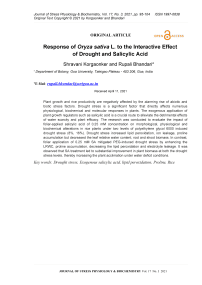Response of Oryza sativa L. to the Interactive Effect of Drought and Salicylic Acid
Автор: Shravani Korgaonker, Rupali Bhandari
Журнал: Журнал стресс-физиологии и биохимии @jspb
Статья в выпуске: 3 т.17, 2021 года.
Бесплатный доступ
Plant growth and rice productivity are negatively affected by the alarming rise of abiotic and biotic stress factors. Drought stress is a significant factor that directly affects numerous physiological, biochemical and molecular responses in plants. The exogenous application of plant growth regulators such as salicylic acid is a crucial route to alleviate the detrimental effects of water scarcity and plant efficacy. The research was conducted to evaluate the impact of foliar-applied salicylic acid of 0.25 mM concentration on morphological, physiological and biochemical alterations in rice plants under two levels of polyethylene glycol 6000 induced drought stress (8%, 16%). Drought stress increased lipid peroxidation, ion leakage, proline accumulation but decreased the leaf relative water content, root and shoot biomass. In contrast, foliar application of 0.25 mM SA mitigated PEG-induced drought stress by enhancing the LRWC, proline accumulation, decreasing the lipid peroxidation and electrolyte leakage. It was observed that SA treatment led to substantial improvement in plant biomass at both the drought stress levels, thereby increasing the plant acclimation under water deficit conditions.
Drought stress, Exogenous salicylic acid, lipid peroxidation, Proline, Rice
Короткий адрес: https://sciup.org/143173906
IDR: 143173906
Текст научной статьи Response of Oryza sativa L. to the Interactive Effect of Drought and Salicylic Acid
Crop plants are continuously exposed to different abiotic stress conditions both in natural and agricultural conditions, affecting their growth and development, thus enabling the plant to develop unique and sophisticated tolerance mechanisms to cope with the environmental constraints. The short-term physiological response or long-term structural, morphological, and physiological modifications help the plant minimize stress. Drought stress is one of the most common and damaging environmental stress factors, decreasing crop productivity compared to other abiotic stress (Lambers and Oliveira, 2019). According to OECD (Organization for Economic Cooperation and Development) estimates, the water demand will be more than double by 2050 and water systems have to provide water for around 9.6 billion people in 2050 (Anon, 2012). The rising population, drastic climatic change, and farming development, where water demand has amplified several folds, will make water scarce in several parts of the world (Mishra and Singh, 2010). The decrease in soil water availability and changing climatic conditions leads to continuous water loss by transpiration or evaporation, causing drought stress (Jaleel et al ., 2008).
Plants on exposure to water stress cause reduced yield and shift themselves in survival mode, ultimately reduce its yield. Therefore, it is essential to control the stress-induced damages to the plant's average growth and development. Many techniques have been used to induce drought mitigation, such as gene transformation and the cultivation of drought-tolerant varieties. However, such methods need specific environmental and edaphic conditions according to individual plants, high financing, technology as it is time-consuming. Thus, exogenous treatment with plant growth regulator (PGR) can be an economical, manageable and uncomplicated substitute as by using the defined application of PGR, the plant will upturn the water use efficiency and acclimatize to drought stress.
Salicylic acid (SA) is a common phenolic compound synthesized by the plant and has diverse physiological roles in photosynthesis, ion uptake and transport, stomatal movement and membrane permeability (Hayat et al., 2008). An individual plant's response to the exogenous application of SA depends entirely on the plant's developmental stage, mode of application, SA concentration, and its endogenous SA level in the plant (Horvath et al., 2007). Singh and Usha (2003) reported that SA's application on drought-stressed wheat seedlings showed higher moisture content, dry matter accumulation, carboxylase activity of RuBisCo, SOD, chlorophyll content compared to control.
Rice ( Oryza sativa L.) is one of the important cereal crops and the staple food for approximately half the world's population (Carriger and Vallee, 2007) and requires water throughout its life cycle compared to other crops. Hence, water stress is a vital threat to the loss of plant productivity in the agricultural system worldwide. The drought stress affects rice at morphological, physiological, and biochemical levels, thereby affecting its yield. The improvement in drought stress tolerance of major food crops is of utmost importance, and hence detailed understanding of various processes that regulate the yield of rice grown under drought stress induced by exogenous application of salicylic acid is a prerequisite. Thus, this experiment was carried out to understand the interactive effect of exogenously applied salicylic acid and drought stress on morphological, physiological and biochemical responses in rice plants from the application point of view.
MATERIALS AND METHODS
Plant material and growth conditions
Rice seeds ( Oryza sativa L.cv. Jaya) were obtained from ICAR - Central Coastal Agricultural Research Institute, Goa. Seeds were surface sterilized and allowed to germinate in plastic pots, 10 cm in diameter containing vermiculite at 25° C ±1 at 16/8 h light/dark periodicity with the light intensity of 200 μmol m-2s-1 and the relative humidity was maintained at 60% -70%.
Induction of drought stress
Rice seeds were subjected to 0% (control), 8% and 16% of water potential using PEG 6000 dissolved in Hoagland's solution (pH 6.4) to fulfil nutrient requirements.
Treatment of plants with salicylic acid
Plants were subjected to salicylic acid with 0.25 mM concentration (pH 7), foliar sprayed on ten-day-old plants for three consecutive days. The concentrations of SA were selected based on earlier findings.
Relative Water Content (RWC) measurement
The RWC is an important index to evaluate plants' physiological water content, was carried out by the standard method (Barrs and Weatherley, 1962). Fresh weight (FW) of randomly chosen leaves was measured and allowed to immerse in distilled water at room temperature in closed petri plates for 24 h to obtain the turgid weight (TW). Tissues were then placed in a preheated oven at 80° C for 48 h to measure the dry weight (DW). RWC was further calculated using the formula:
RWC (%) = [(FW-DW)/(TW-DW) x 100
Biomass analysis
The fresh and dry weight of shoots and roots were recorded by randomly selecting ten plantlets from respective concentrations. For obtaining the dry weight, the samples were oven-dried at 70° C for 72 h (Chen et al ., 2014).
Estimation of electrolyte leakage
Total ion leakage from fully expanded leaves was determined using Shi et al ., (2006). Twenty leaf discs were placed in 50 ml glass vials, rinsed with distilled water to eliminate the electrolytes released during leaf disc excision. Vials then filled with 20 ml of distilled water were allowed to stand in the dark for 24 h at room temperature. The electrical conductivity (EC1) of the solution was determined at the end of the incubation period. Vials were then heated in a temperature-controlled water bath at 95oC for 30 min, cooled at room temperature, and measured electrical conductivity (EC2) using Waterproof PCTestr 35 pH/Conductivity. Electrolyte leakage was calculated as the percentage of (EC1/EC2) x 100.
Determination of lipid peroxidation
The extent of lipid peroxidation was assessed by quantifying the malondialdehyde (MDA) content, the end product of lipid peroxidation, according to Sharma, (2002). Leaf samples (0.5g) was homogenized with 5 ml of 1% trichloroacetic acid (TCA) in an ice bath. The homogenate was centrifuged at 12000 g for 10 min, and the supernatant was used for lipid peroxidation analysis.
To the 1 ml aliquot of supernatant, 2.5 ml of 0.5% thiobarbituric acid (TBA) in 20% TCA and 2.5 ml of incubation buffer was added. The mixture was incubated for 30 min at 95° C . MDA content was detected spectrophotometrically at 532 nm and altered for nonspecific turbidity at 600 nm. The extinction coefficient of 155 mM-1 cm-1 was used for MDA quantification.
Determination of Proline content
The free proline content in leaf tissue was determined by Bates et al ., (1973). 0.5 g of leaf tissue was homogenized in 5 ml of 3% (v/v) aqueous sulfosalicylic acid followed by centrifugation at 5000 rpm for 5 min. 1 ml of supernatant was mixed with 1 ml of freshly prepared acid ninhydrin and glacial acetic acid. The mixture was heated at 90oC for an hour; the developed colour was extracted in 5 ml of toluene with vigorous shaking. The tubes were set aside to stand for 10 min to allow separation of toluene and aqueous phase. The absorbance of the toluene phase was measured spectrophotometrically at 520 nm. A standard curve prepared with analytical grade proline was used for the final calculations.
Data analysis
Each experiment was repeated thrice and the data presented are with a mean of n=3. The data analysis was carried out using standard error ± in MS Excel.
RESULTS
Effect of drought and SA on plant biomass:
Our results in Fig. 1 and Table 1 indicate that increasing drought stress levels from 8% to 16% progressively decreased plant biomass [above (57% and 74%) and below (4% and 17%) -ground] compared with the control plants. Exogenous application of SA increased the drought-affected growth in 8% drought-stressed rice by 14% and 23% in above and belowground biomass as compared to SA untreated 8% rice plants, whereas as 16% drought-stressed rice plants showed an increase in above-ground biomass by 135% as compared to SA untreated 16% stressed plants.
Effect of drought and SA on Relative Water Content in rice:
We observed that drought stress reduced the leaf RWC as the PEG level increased (8% by 89%; 16% by
79%) (Fig. 2 and Table 1). The well-watered or drought-stressed seedlings showed higher RWC with SA treatment than without SA. The application of 0.25 mM SA caused an increase in RWC (14%) in stressed seedlings, which seems to be more evident at the highest drought stress level of 16% compared to 16% untreated plants.
Effect of drought and SA on membrane integrity:
As drought stress boosts free radicals levels in plants, the damage caused to the membrane was examined by monitoring total ion leakage (Fig. 3 and Table 1). Our findings show that electrolyte leakage increased from 25% to 46% as the stress level elevated from 8% to 16 %. The exogenous SA treatment of 0.25 mM led to electrolyte leakage from 26% to 39%, respectively from 8% to 16% in drought-stressed rice seedlings compared to well-watered plants.
Effect of drought and SA on lipid peroxidation:
Our study indicates the level of membrane damage as the product of lipid peroxidation caused by the increased level of free radicals due to induced drought stress (Fig. 4 and Table 1). Lipid peroxidation increased as the stress level elevated, i.e. in 8% by 56% and in 16% by 350%. The exogenous SA treatment of 0.25 mM led to downregulation of MDA content by 25% and 15% in 8% and 16% drought-stressed rice seedlings compared to well-watered rice seedlings.
Effect of drought and SA on proline content:
Our findings indicate that increased proline content is associated with increasing drought stress levels (Fig. 5 and Table 1). The highest level of proline content in plants is directly related to the severity of drought stress to which plants are exposed, i.e. 16% of PEG-induced drought stress in combination with 0.25 mM SA (1.2 folds increase) and the minimum amount of proline obtained in plants exposed to well-watered conditions without SA. The application of SA improved the resistance of plants to water stress. This increased defence was predominant under 0.25 mM SA in 8% (1.6 folds increase).
Table 1: The effect of exogenous salicylic acid on rice ( Oryza sativa L.cv. Jaya) under PEG 6000 induced drought stress
|
TREATMENT |
Biomass |
RWC |
EL |
MDA |
Proline |
|
|
AG |
BG |
|||||
|
CONTROL |
0.519±0.06 |
0.434±0.03 |
94±0.04 |
13.8±0.06 |
0.0021±0.0002 |
0.552±0.002 |
|
CONTROL + 0.25 SA |
0.551±0.03 |
0.449±0.04 |
97±0.08 |
12.8±0.07 |
0.0018±0.0001 |
0.460±0.006 |
|
8% PEG |
0.225±0.03 |
0.418±0.06 |
89±0.20 |
14.3±0.04 |
0.0032±0.0002 |
2.335±0.010 |
|
8% + 0.25 SA |
0.256±0.02 |
0.516±0.03 |
93±0.25 |
13.2±0.20 |
0.0025±0.0001 |
3.811±0.111 |
|
16% PEG |
0.134±0.01 |
0.360±0.03 |
79±0.36 |
17.8±0.06 |
0.0093±0.0006 |
12.160±0.081 |
|
16% + 0.25 SA |
0.152±0.01 |
0.324±0.05 |
90±0.01 |
16.6±0.03 |
0.0080±0.0006 |
14.573±0.088 |
Data are given as mean, n=3. Error bars ± indicate standard error (SE). AG (Above ground); BG ( Below ground); RWC (Relative Water Content); EL (Electrolyte Leakage); MDA (Malondialdehyde);
BIOMASS nR00T asHooi
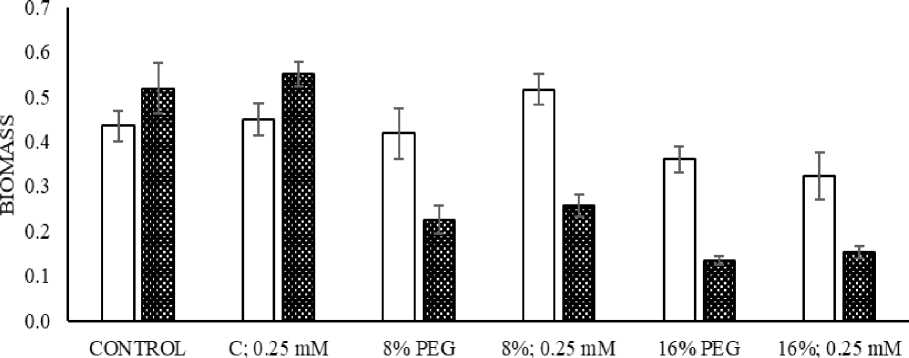
TREATMENTS: (PEG: SA)
Figure1. Effect of PEG induced drought and SA on plant biomass in rice ( Oryza sativa L.). Data are given as mean, n=3. Error bars ± indicate standard error (SE).
RELATIVE WATER CONTENT
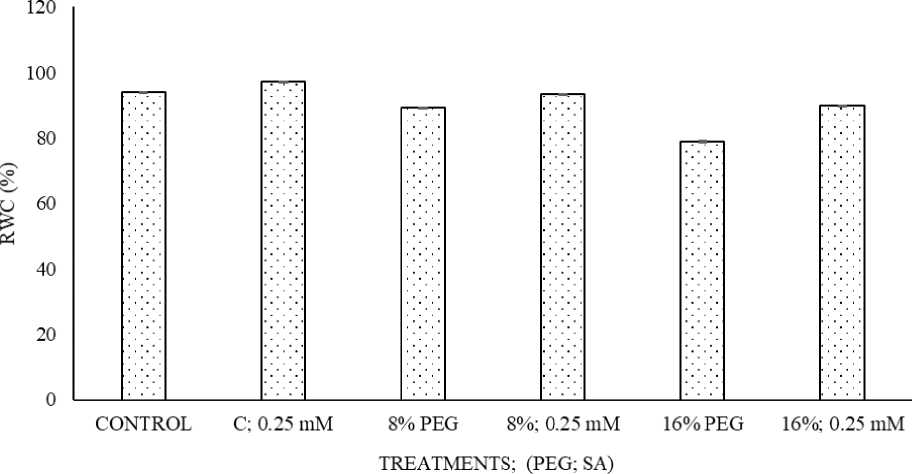
Figure 2. Effect of PEG induced drought and SA on Relative water content (RWC) in rice ( Oryza sativa L.). Data are given as mean, n=3. Error bars ± indicate standard error (SE).
ELECTROLYTE LEAKAGE
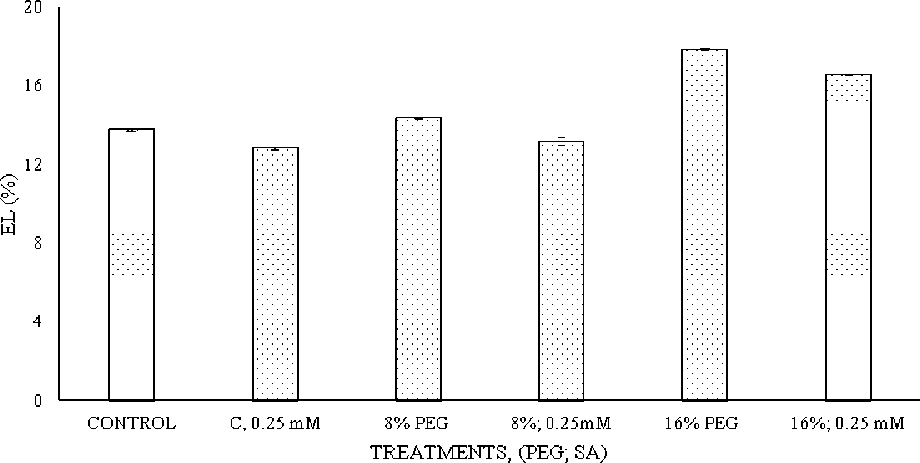
Figure 3 . Effect of PEG induced drought and SA on electrolyte leakage in rice ( Oryza sativa L.). Data are given as mean, n=3. Error bars ± indicate standard error (SE).
MDA
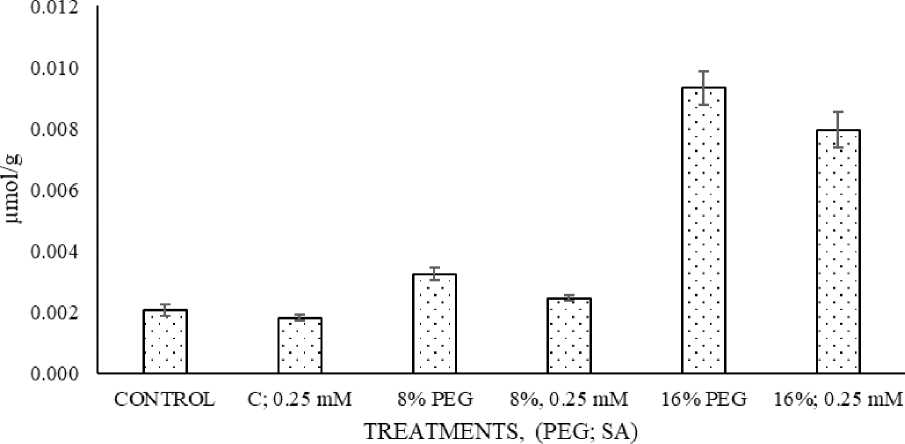
Figure 4. Effect of PEG induced drought and SA on lipid peroxidation in rice ( Oryza sativa L.). Data are given as mean, n=3. Error bars ± indicate standard error (SE).
PROLINE
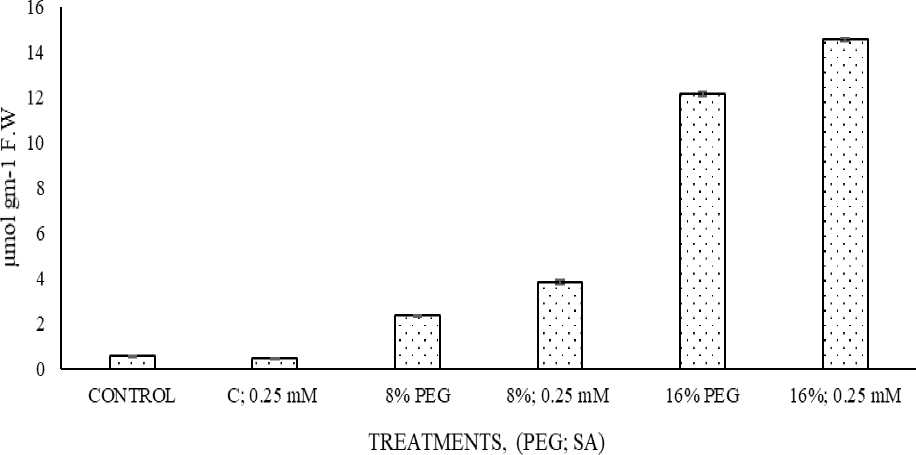
Figure 6. Effect of PEG induced drought and SA on proline content in rice ( Oryza sativa L.). Data are given as mean, n=3. Error bars ± indicate standard error (SE).
DISCUSSION
Drought is a crucial environmental factor that affects plants' growth and physiological characteristics Xiangwen et al., 2009). According to Bray (1997), plant response to drought stress has been reported is based on various factors such as period, the severity of water stress, age, individual development stages, species and genotype (Kabiri et al ., 2014).
Our study on the foliar application of SA on rice Oryza sativa L.) seedlings alleviated the effects of drought stress. PEG induced drought stress caused a drastic reduction in growth and biomass (FW, DW) of root and shoot in rice plants, while the degree of reduction was more in 16% as compared to 8% and well-watered plants, however, recovered with exogenous SA application (Fig.1). This drastic interference in growth and biomass is due to the reduction in cell division and elongation. Similar findings were documented by Hu and Schmidhalter (2005). According to Loutfy et al., (2012), plant treatment with SA may confer resistance to drought since SA is attributed to stimulating growth. Boyer (1970) reported that the growth and expansion of young leaves' are sensitive to water deficit rather than photosynthesis. Therefore we can deduce that water-sensitive activities determine the growth rate of the plant.
LRWC is a vital indicator to verify the plant's water status, reflecting on the absolute amount of water, which the plant requires to carry out its metabolic activity influencing growth (Sinclair and Ludlow, 1986). In the present study, we observed that drought stress down-regulated LRWC in rice plants and exogenous SA treatment improved the drought stress effect on LRWC (Fig. 2). Here we could analyze that rice leaves' water status was subjected to 8% and 16% stress and SA, which depends on the respective shoot and root biomasses. This can also suggest that rice plants with the greater biomass of root or shoot can maintain the higher water content in the leaf and be more acclimatized to drought.
This study observed that as drought stress increased from 8% to 16%, it enhanced free radicals levels in plants, causing damaging effects on the membranes, which was investigated by monitoring electrolyte leakage and MDA content (Fig. 3 and 4). Electrolyte leakage facilitates the assessment of cell membrane injury caused to plants when exposed to drought stress. Sairam et al., (2001) have reported that drought-stressed condition is considered an integral part of drought tolerance mechanism, thereby maintaining cell membrane integrity. Our study also reported an increase in electrolyte leakage. However, SA treatments lowered the leakage in 8% and 16% drought-stressed rice plants (Fig. 3). According to Jaleel et al., (2007), a reduced electrolyte leakage level indicates the leaf membrane's stability. It was observed by Yusuf et al., (2008) that SA application enhanced the antioxidant system necessary in reducing oxidative damage and ion leakage from the membrane. Thus, SA upsurges the accumulated Ca+2, thereby maintaining the membrane integrity Khan et al., 2010). Our findings suggest that exogenously applied SA may positively affect plant growth and development under stress conditions.
The amount of MDA content is used as a marker for lipid peroxidation in oxidative stress studies mainly focused on plant responses to abiotic and biotic stresses Al-whaibi et al ., 2012). Our study also showed that the level of MDA content in rice plants increased as drought stress increased (Fig. 4). Our observations were on par with previous studies in barley subjected to salt and water deficit reported by Fayez and Bazaid, (2014). Bor et al ., (2003) also reported that salt stress increased lipid peroxidation in beet species. The application of 0.25 mM SA remarkably decreased MDA content in both drought stress conditions, i.e., 8% showed a decrease by 25% and 16% by 15%. Similar results were obtained by Chen et al ., (2014), who showed that SA treatment might decrease the damaging effects of drought stress on the membrane.
Xue et al., (2008) observed that accumulation of proline in plants is one of the firm strategies for osmotic adjustment for coping with water shortage. Under unfavourable conditions, proline acts as a compatible solute for osmotic adjustment and protects the macromolecular structures and cell membrane. We have observed an upregulation of proline content in drought-stressed rice plants (8% and 16%), and its value increased by applying SA, which helps ameliorate the detrimental effects of unfavourable conditions (Fig. 5). Similar elevation in proline content was observed by Tasgin et al., (2006) in bean, wheat, and tomato under drought stress condition. Our observations were in conformity with studies reported by (Raskin, 1992; Shah, 2003), suggesting that SA application alleviates detrimental effects of drought stress by accumulating proline. Nazar et al., (2015) also reported the amelioration of drought-induced oxidative stress due to the accumulation of proline in mustard.
CONCLUSION
Our study has proven that on the application of SA exogenously, plants can mitigate the damaging effects of drought stress in rice plants. SA of 0.25 mM concentration alleviated the adverse effects of drought stress on rice. According to the results obtained, we can suggest that SA may, in the future, have applications in improving plant growth and yield in drought-prone areas.
ACKNOWLEDGMENTS
We acknowledge University Grants Commission, New Delhi, India, for financial support under the National Fellowship for OBC. Authors thank ICAR - Central Coastal Agricultural Research Institute, Goa, India, for the rice seeds.
CONFLICTS OF INTEREST
All authors have declared that they do not have any conflict of interest for publishing this research.
Список литературы Response of Oryza sativa L. to the Interactive Effect of Drought and Salicylic Acid
- Al-Whaibi, M. H., Siddiqui, M. H., and Basalah, M. O., (2012). Salicylic acid and calcium-induced protection of wheat against salinity. Protoplasma, 249(3), 769–778.
- Anon. Department of Economic and Social Affairs, Population Division, United Nations. (2012). World Population Prospects: The 2012. Revision, Volume I: Comprehensive Tables (ST/ESA/ Anonymous, 1997. European Pharmacopoeia (3r Edn), Council of Europe, Strasbourg, France, 121-122.
- Barrs, H. D., and Weatherley, P. E., (1962). A reexamination of the relative turgidity technique for estimating water deficit in leaves. Australian Journal of Biological Sciences, 15(3), 413–428.
- Bates, L. S., Waldren, R. P., and Teare, I. D., (1973). Rapid determination of free proline for water-stress studies. Plant and Soil, 39(1), 205–207.
- Bor, M., Özdemir, F., and Türkan, I., (2003). The effect of salt stress on lipid peroxidation and antioxidants in leaves of sugar beet Beta vulgaris L. and wild beet Beta maritima L. Plant Science, 164(1), 77–84.
- Boyer, J. S., (1970). Differing sensitivity of photosynthesis to low leaf water potentials in corn and soybean. Plant Physiology, 46(2), 236–239.
- Bray, E. A., (1997). Plant responses to water deficit. Trends in Plant Science, 2(2), 48–54.
- Carriger, S., and Vallée, D., (2007). More crop per drop. Rice Today, 6(2), 10–13.
- Chen, Z. L., Li, X. M., and Zhang, L. H., (2014). Effect of salicylic acid pretreatment on drought stress responses of zoysiagrass (Zoysia japonica). Russian Journal of Plant Physiology, 61(5), 619–625.
- Fayez, K. A., and Bazaid, S. A., (2014). Improving drought and salinity tolerance in barley by application of salicylic acid and potassium nitrate. Journal of the Saudi Society of Agricultural Sciences, 13(1), 45–55.
- Hayat, S., Hasan, S. A., Fariduddin, Q., and Ahmad, A., (2008). Growth of tomato (Lycopersicon esculentum) in response to salicylic acid under water stress. Journal of Plant Interactions, 3(4), 297–304.
- Horváth, E., Szalai, G., and Janda, T., (2007). Induction of abiotic stress tolerance by salicylic acid signalling. Journal of Plant Growth Regulation, 26(3), 290–300.
- Hu, Y., and Schmidhalter, U., (2005). Drought and salinity: A comparison of their effects on mineral nutrition of plants. Journal of Plant Nutrition and Soil Science, 168(4), 541–549.
- Jaleel A, Gopi R, Sankar B, Manivannan P, Kishorekumar A, Sridharan R and Panneerselvam R., (2007). Studies on germination, seedling vigour, lipid peroxidation and proline metabolism in Catharanthus roseus seedlings under salt stress. South African Journal of Botany 73, 190–5
- Jaleel, C. A., Sankar, B., Murali, P. V., Gomathinayagam, M., Lakshmanan, G. M., and Panneerselvam, R., (2008). Water deficit stress effects on reactive oxygen metabolism in Catharanthus roseus. Impacts on ajmalicine accumulation. Colloids and Surfaces. B, Biointerfaces, 62(1), 105–111.
- Kabiri, R., Nasibi, F., and Farahbakhsh, H., (2014). Effect of exogenous salicylic acid on some physiological parameters and alleviation of drought stress in Nigella sativa plant under hydroponic culture. Plant Protection Science, 50(1), 43–51.
- Khan, N., Syeed, S., Masood, A., Nazar, R., and Iqbal, N., (2010). Application of salicylic acid increases contents of nutrients and antioxidative metabolism in mungbean and alleviates adverse effects of salinity stress. Intl. J. Plant. Biol. 1:e1.
- Lambers, H., and Oliveira, R. S., (2019). Plant physiological ecology. In Plant Physiological Ecology.
- Loutfy, N., El-Tayeb, M.A., Hassanen, A.M., Moustafa, M.F., Sakuma,Y., and Inouhe M., (2012). Changes in the water status and osmotic solute contents in response to drought and salicylic acid treatments in four different cultivars of wheat (Triticum aestivum L.). J. Plant Res. 125: 173-184.
- Mishra, A. K., and Singh, V. P., (2010). A review of drought concepts. Journal of Hydrology, 391(1–2), 202–216.
- Nazar, R., Umar, S., Khan, N. A., and Sareer, O., (2015). Salicylic acid supplementation improves photosynthesis and growth in mustard through changes in proline accumulation and ethylene formation under drought stress. South African Journal of Botany, 98, 84–94.
- Raskin, I., (1992). Role of salicylic acid in plants. Annu. Rev. Plant Biol. 43, 439–463.
- Sairam, R. K., Chandrasekhar, V. and Srivastava, G. C., (2001). Comparison of hexaploid and tetraploid wheat cultivars in their responses to water stress. Biologia Plantarum, 44(1): 89-94.
- Sharma P. K., (2002) Photoinhibition of photosynthesis and mechanism of protection against photodamage in crop plants. Everyman's Sci 36:237–252
- Shah, J., (2003). The salicylic acid loop in plant defense. Curr. Opin. Plant Biol. 6, 365–371.
- Shi, Q. H., Zhu, Z. J., Juan, L. I., and Qian, Q. Q. (2006). Combined effects of excess Mn and low pH on oxidative stress and antioxidant enzymes in cucumber roots. Agricultural Sciences in China, 5(10), 767-772.
- Sinclair, T. R., Muchow, R. C., Ludlow, M. M., Leach, G. J., Lawn, R. J., and Foale, M. A., (1987). Field and model analysis of the effect of water deficits on carbon and nitrogen accumulation by soybean, cowpea and black gram. Field Crops Research, 17(2), 121–140.
- Singh, B., and Usha, K., (2003). Salicylic acid induced physiological and biochemical changes in wheat seedlings under water stress. Plant Growth Regulation, 39(2), 137–141.
- Taşgin, E., Atici, O., Nalbantoğlu, B., and Popova, L. P., (2006). Effects of salicylic acid and cold treatment on protein levels and on the activities of antioxidant enzymes in the apoplast of winter wheat leaves. Phytochemistry, 67(7), 710–715.
- Xiangwen X., Fan Y., Sheng Z., Helena K., Chunyang L., (2009). Physiological and proteomic responses of two contrasting Populus cathayana populations to drought stress. Physiologia Plantarum, 136: 150–168
- Xue, G. P., McIntyre, C. L., Glassop, D. and Shorter, R., (2008). Use of expression analysis to dissect alterations in carbohydrate metabolism in wheat leaves during drought stress. Plant Molecular Biology 67, 197-214.
- Yusuf, M., Hasan, S. A., Ali, B., Hayat, S., Fariduddin, Q., and Ahmad, A., (2008). Effect of salicylic acid on salinity‐induced changes in Brassica juncea. Journal of Integrative Plant Biology, 50(9), 1096–1102.

